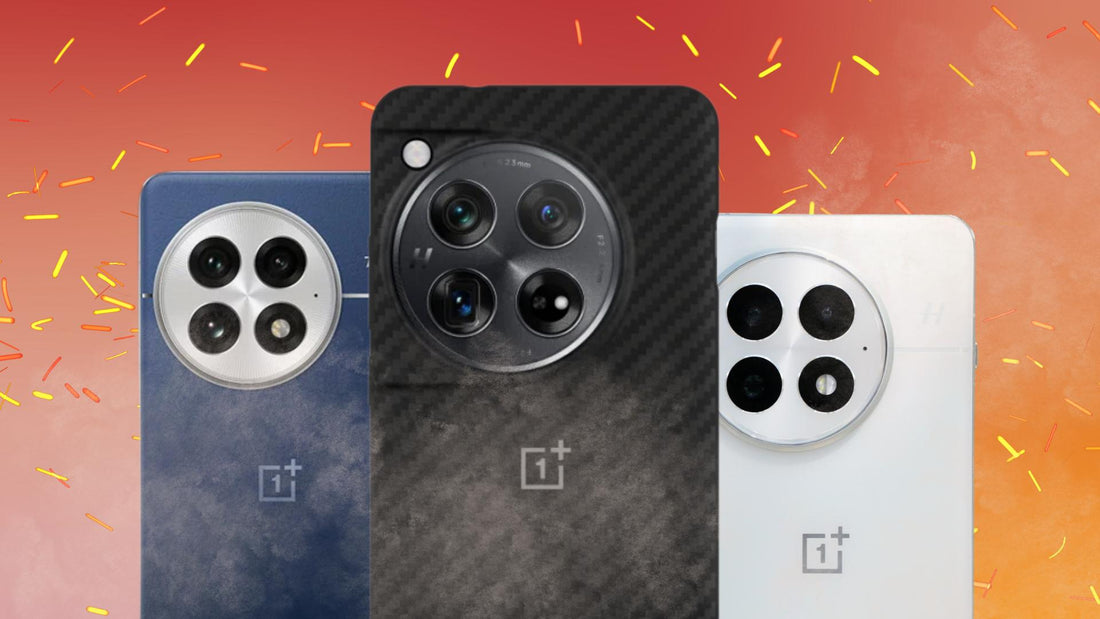
How to Fix the OnePlus 13 Overheating
Share
We can safely say on behalf of many fans that the OnePlus 13 is a beast phone. However, we've unfortunately faced phone overheating problems during usage. This proves that even the most well-built devices can overheat under certain conditions, making the overall experience very uncomfortable. Not to mention the safety risks and long-term damage to your device, slash investment.
OnePlus has addressed overheating issues with its earlier models and provided tips to prevent them. For the OnePlus 13 specifically, we had to take fixes from personal experience. In this guide, we’ll explore the causes of the OnePlus 13 overheating, potential dangers, and practical steps you can take to cool down your OnePlus phone.
Table of Contents
Why Is Your OnePlus 13 Overheating?

According to OnePlus, it's generally normal for a OnePlus device to get slightly warm during use, just like all smartphones. However, uncomfortable warmth is a different story. There are a number of reasons why the OnePlus 13 can overheat. Its predecessors, such as the OnePlus 12 and lower, experienced excessive overheating, particularly during gaming. One user reported that the OnePlus 12 reached temperatures above 41°C within 15-20 minutes of gaming, causing discomfort and potentially damaging the device. Despite the advertised new cooling system, the phone still overheats significantly, indicating a potential design flaw or manufacturing issue.
Moreover, the phone's performance (FPS) doesn't noticeably improve even with higher performance modes, suggesting that the overheating is limiting performance gains. The heat primarily originates from the screen and sides, suggesting a potential issue with heat dissipation in those areas.
Here's our two cents regarding the possible causes of overheating for this particular case:
- Faulty Cooling System: The advertised cooling system may not be functioning as intended or may have a manufacturing defect.
- Software Issues: Software bugs or glitches could be causing the processor to work harder than necessary, leading to excessive heat.
- Hardware Issues: There might be a hardware problem with the processor, graphics chip, or other components.
- Game Optimization: The specific games you're playing might not be optimized well for the OnePlus model you have, leading to inefficient resource usage and excessive heat.
11 Common Causes of the OnePlus 13 Overheating
Common reasons that could contribute to your OnePlus 13 overheating include the following:
1. Running Too Many Background Apps
Keeping multiple apps running simultaneously increases your phone’s workload, causing the processor to overheat. This is particularly true for resource-heavy apps like games, video editing software, or streaming platforms.
2. High Screen Brightness
Your display is one of the most power-hungry components of your phone. Running it at maximum brightness for extended periods can cause your device to heat up.
3. Intensive Apps or Tasks
Intensive activities, such as playing graphically demanding games or recording videos in 4K resolution, can push your phone’s hardware to its limits, leading to overheating.
4. Background Processes
Unnecessary background processes, such as updates or syncing, consume resources and contribute to heat generation.
5. Poor Battery Health
As a battery ages, its performance degrades. A deteriorating battery can generate more heat than normal during charging or usage.
6. Environmental Factors
Hot weather, direct sunlight, or placing your phone near heat-generating devices can exacerbate overheating issues.
7. Using the Phone while Charging
This puts extra strain on the battery, causing it to heat up. Moreover, it's not an ideal practice as it deteriorates your overall battery health faster.
8. Phone Case with Poor Heat Dissipation
Some phone cases, especially thick ones, trap heat and worsen the issue. We recommend getting a super thin OnePlus 13 case made of aramid fiber.
9. Continuous Navigation Use
Long GPS usage and bright screens cause phones to heat up. If you need to use these navigation apps when traveling far, consider lowering your screen brightness and using a phone mount with built-in cooling or ventilation.
10. Hotspot Use
Signal transmission and data sharing generate heat during hotspot use. If you frequently use your OnePlus phone as a hotspot, it’s important to manage the heat it generates. Prolonged hotspot usage pushes your phone’s processor and cellular antenna to work harder, increasing the risk of overheating.
11. Using Phones in Poor Signal Areas
Weak networks force the phone to use more power to maintain a connection, leading to heat.
How to Cool Down Your Overheated OnePlus 13

Once you've identified the root cause of your OnePlus overheating, it's now easier to determine the right fix. Continue reading to learn more about simple solutions to the OnePlus 13 overheating.
Fix 1. Close Background Apps
Reducing the number of apps running simultaneously can ease the load on your phone’s processor. Here’s how to close apps:
Step 1: Swipe up from the bottom of the screen (for gesture navigation) or tap the Recent Apps button.
Step 2: Swipe away apps you don’t need or press “Close All” to stop all background processes.
Fix 2. Fan the Phone
Gently fanning your phone or blowing on it can help dissipate heat faster. Avoid using extreme measures like placing the phone in a freezer, as this can cause condensation and damage internal components. We've confirmed that OnePlus will release a wireless charger with a cooling fan and other power accessories on the global OnePlus 13 launch.
Fix 3. Avoid Sudden Temperature Changes
While it may be tempting to place an overheated phone in a cold environment, rapid temperature shifts can cause materials inside the phone to expand or contract, leading to internal damage.
Fix 4. Remove the Case
Phone cases, especially thick or poorly ventilated ones, can trap heat. Removing the case allows the phone to release heat more effectively. Alternatively, you can use a OnePlus 13 slim case that will not compromise on performance, allowing your device to breathe while in use.
Fix 5. Turn Off Bluetooth
Bluetooth functionality requires power, and keeping it on when not in use can contribute to overheating. Turn it off by:
Step 1: Swiping down on the notification bar.
Step 2: Tapping the Bluetooth icon to disable it.
Fix 6. Enable Airplane Mode
Airplane Mode disables cellular, Wi-Fi, and Bluetooth connections, reducing the workload on your phone. To turn it on:
Step 1: Open the notification shade.
Step 2: Tap the Airplane Mode icon.
Fix 7. Separate Your Phone from Other Devices
Electronic devices generate heat, and keeping your phone near them can amplify overheating. Place your phone in a well-ventilated area, away from other gadgets.
What Else Can You Do to Solve the OnePlus 13 Overheating Issue?
If the steps above don't work, consider doing the following steps:
- Disable 5G if it's of no use to you (avoids heating and avoids drain).
- Keep the display resolution on Auto and disable the screen sharpener.
- Disable pocket miss touch.
- Disable virtual RAM (turned on by default).
- Keep refresh rate Auto.
- Disable high-performance mode.
Extra tip that matters: If those still don't solve the issue, you can back up your phone and then do a full factory reset.
Why the OnePlus 13 Overheating Is a Serious Concern
Overheating is an inconvenience and can lead to severe consequences, such as:
Thermal Runaway
This dangerous condition occurs when a battery overheats to the point where it expands, heats up rapidly, and potentially catches fire.
Battery Degradation
Excessive heat reduces your battery’s lifespan and its ability to hold a charge.
Device Damage
Overheating can harm internal components like the processor, screen, and storage.
Performance Throttling
Your phone may intentionally slow down to protect itself, leading to laggy performance.
Nonetheless, the OnePlus 13 battery has proven to be powerful and long-lasting.
Danm still 50% battery left and nearly 7 hours screen on time OnePlus 13 is definitely battery champ 🏆 this is only social media use etc so light usage on WiFi but still pic.twitter.com/5Lg078Nl96
— rick (@rick00357876097) November 30, 2024
When to Seek Professional Help
If your OnePlus phone continues to overheat despite following these steps, it’s time to seek expert assistance. Persistent overheating could indicate deeper issues such as hardware defects, battery malfunction, or software bugs. Visit an authorized OnePlus service center to diagnose and resolve the problem.
Final Thoughts
Overheating can compromise your OnePlus 13's performance, safety, and longevity. You can prevent and address overheating effectively by understanding the causes and implementing practical solutions—like using a thin phone case. Regular maintenance, careful app usage, and proper charging practices go a long way in ensuring your device stays cool and functions optimally.
Take these precautions to protect your OnePlus phone, and enjoy a smooth, worry-free user experience!
Products Featured in This Blog
Frequently Asked Questions
How can I prevent overheating while gaming on my OnePlus 13?
To reduce heat during gaming, lower the graphics settings, enable Game Mode, and take breaks to let the phone cool. Avoid gaming while charging, and consider using a cooling fan accessory for extended sessions.
Does fast charging contribute to overheating on the OnePlus 13?
Yes, fast charging generates more heat than standard charging. Use official OnePlus chargers, and avoid using your phone during the process to minimize overheating.
What is the ideal temperature range for the OnePlus 13?
The OnePlus 13 operates optimally between 0°C and 35°C. If it feels uncomfortably hot or reaches over 45°C, take immediate steps to cool it down.
What accessories can help with cooling the OnePlus 13?
Consider investing in phone mounts with built-in fans, cooling pads, or thin, heat-dissipating cases like those made from aramid fiber. These accessories help manage heat during intensive tasks.



